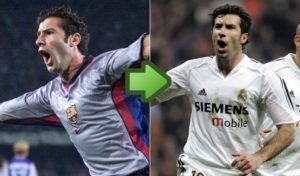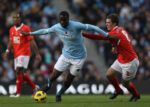Could we write a series like this without this man? The most infamous of the Clásico Heartbreakers, followed by some honourable mentions…
Clásico appearances: 23 (14 for Barcelona, 9 for Real Madrid)
Clásico goals: 4 (3 for Barcelona, 1 for Real Madrid)
Barcelona record: W7 D4 L3
Real Madrid record: W4 D3 L2
Even before arriving in Spain, Luis Figo was at the heart of transfer controversy. Having unwittingly entered an agreement with Juventus in 1995 due to the influence of his club, Sporting Lisbon, an angered Figo then attempted to sign a contract with Parma. As a result, Figo was banned from transferring to an Italian club for two years, something he attributes to the influence of corrupt Juventus director Luciano Moggi. However, Barcelona came to the rescue with a bid of £2.25 million for the Portugal international.
Figo was initially billed as a replacement for Michael Laudrup, who had moved to bitter rivals Real Madrid a year ago. But soon after arriving at the Camp Nou he was moved from a central position to the right wing, where he would play the best football of his career. Possessing excellent ball control, great awareness of his team-mates’ movement and an unpredictable burst of acceleration, Figo was instrumental as Barca won La Liga in 1998 and 1999, the Copa del Rey in 1997 and 1998 and the Cup Winners’ Cup in 1997.
The Blaugrana were also getting the better of rivals Real Madrid in clashes between the two. Figo was a big-game player, and made the difference in these key encounters. He had a key role in his team’s double over Real Madrid in the 1997/98 season – here we see him racing through to set up Giovanni for a dramatic late winner at the Bernabéu.
In the return Clásico at the Camp Nou, Barca romped to a 3-0 victory, Figo scoring one of the finest goals of his career with this left-foooted screamer.
This relationship was to turn sour as Figo demanded a higher wage, claiming that the club undervalued him. Months of speculation over the possibility of a move to Italy passed, but the eventual outcome was far more dramatic. Real Madrid broke the world transfer record, paying £38 million to bring Figo to the Spanish capital and begin the galactico era.
If he wasn’t feeling fully appreciated before, this was about to change; being awarded the Ballon d’Or as Real won the league title in his debut season. Another title win would come in the 2002/03 season, but the greatest moment of Figo’s time at the club was the Champions League win of 2002. Labelled by critics beforehand as the “match of the century”, Madrid faced Barcelona in the semi-final. Figo missed the first leg but featured in the second as Los Merengues won the European Clásico 3-1 aggregate before defeating Bayer Leverkusen 2-1 at Hampden Park.
But while becoming a hero at Madrid, the fans who had idolised him before his move would also make their feelings clear. Most infamous is the Clásico of November 2002, at the Camp Nou. While it was a fairly unremarkable 0-0 draw, it’s memorable for the hostile reception given by Los Cules to Figo; jeering his every touch as well as throwing coins and bottles when he went to take corners. And of course, the pig’s head.
Figo would eventually leave Madrid in 2005, as the galactic project began to fall apart. Moving to Inter, he enjoyed a successful end to his career, making 132 appearances and winning 4 Scudetti. He remains at the San Siro in a backroom role, happy to be away from the country where he caused so much controversy. A truly controversial figure, seen by many as a mercenario, he must at least be remembered as one of the greatest players to have played for either Real or Barca and a key figure in the history of the Clásico.
Plays like…
It’s clear that Figo, as the protagonist of Portugal’s “Golden Generation”, was a huge influence on many wingers such as Real Madrid’s Cristiano Ronaldo. But Ronaldo’s explosive, powerful style is at odds Figo’s more measured approach. Players like Mesut Özil and Andrés Iniesta, primarily creative with a tendency to move into wide positions, seem to mirror Figo’s style better.
Honourable mentions
Or should that be dishonourable mentions? Here are some players who’ve played for both Real Madrid and Barcelona; not all of them, however, have donned both shirts in the Clásico.
Josep Samitier – A colourful figure, who is still Barcelona’s second-highest goalscorer. However, he transferred to Real Madrid in 1932 and went to score three Clásico goals against his former employers. Going on to become a manager then scout for Barcelona, he again defected to Real Madrid and hijacked the Alfredo di Stefano transfer. Still seen as a Barca hero despite his betrayal and his friendship with Franco.
Ricardo Zamora – Legendary Spanish ‘keeper spent three years at Barcelona and six at Real Madrid.
Alfredo di Stefano – One of the greatest players in history and the top scorer in the history of the Clásico with 18 goals. While never being a Barcelona player, he gets a mention for agreeing to sign for Barcelona before being persuaded to join Madrid when arriving in Spain in 1953, a saga that intensified the rivalry between the teams.
Luis Milla – The defensive midfielder came up through Barcelona’s academy and had started to establish himself in the first team. But after a disagreement over his contract renewal, he joined Real Madrid on a free transfer in 1990 and would go on to make over 200 appearances for the Castilian giants.
Gheorghe Hagi – Despite enjoying a good second season with Real Madrid, the Romanian midfielder, was sold to Brescia in 1992. After shining at the 1994 World Cup he went to Barcelona, but didn’t really settle, eventually moving to Turkish giants Galatasaray where he played his best football.
Robert Prosinecki – The Croatian playmaker was something of a journeyman. He spent three years
at Real Madrid at the start of the ‘90s, scoring in a Clásico, but joined Barcelona in 1996 after more travels. He left the Camp Nou after just a year, eventually becoming a cult hero at Portsmouth.
Samuel Eto’o – Barcelona were keen to sign the Cameroonian after he impressed at Real Mallorca, with the small problem that he was co-owned by Real Madrid. However, a large transfer fee meant that Eto’o got his move and went on to be prolific for the Catalans, winning three league titles and two Champions leagues.
Javier Saviola – Impressed as a youngster at Barca, but lost form and favour and failed to make an impact after moving to Madrid on a free transfer.










Recent Comments